<< Previous | Displaying results 4751-4775 of 6769 for "" | Next >>
Ruins in Oradour-sur-Glane, France. The town was destroyed by the SS on June 10, 1944. Photograph taken in September 1944.

A prisoner in a compression chamber loses consciousness before dying during a medical experiment simulating high altitudes. Dachau Concentration Camp, Germany, 1942.
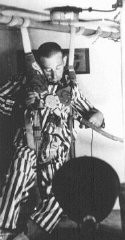
Four days after the outbreak of World War II, Secretary of State Cordell Hull signs the Neutrality Proclamation (first signed by President Franklin D. Roosevelt) at the State Department. Washington, DC, United States, September 5, 1939.
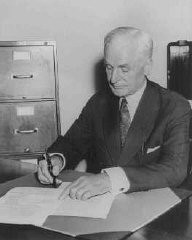
Cover of The Jewish Peril: The Protocols of the Learned Elders of Zion, published in London, 1920. The Protocols of the Elders of Zion is the most notorious and widely distributed antisemitic publication of modern times. Its lies about Jews, which have been repeatedly discredited, continue to circulate today, especially on the Internet.
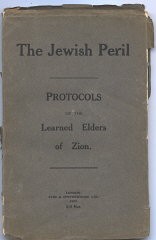
By 1922, The International Jew was already in its 21st printing in Germany. The edition shown here was published in Leipzig in 1922.
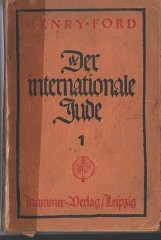
An exhibition at the United States Holocaust Memorial Museum demonstrated how the Nazis used the Protocols of the Elders of Zion to spread hatred of Jews. Washington, D.C., 2006-2018.
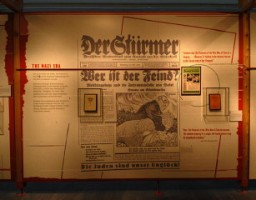
Exterior view of the ORT (Organization for Rehabilitation through Training) supply and transport building in the Foehrenwald displaced persons camp. Foehrenwald, Germany, 1953. This slide was taken by David Rosenstein during his inspection tour of the camp. After his return from the inspection tour in 1953, he briefed Congress on the plight of the remaining Jewish displaced persons in Europe and their inability to find permanent homes, nine years after the end of the war.
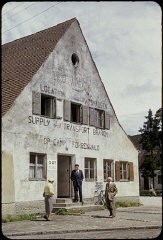
Former quarters of the German army converted into displaced persons housing. Bergen-Belsen, Germany, May 1945.

The exterior of a building in the Bergen-Belsen displaced persons camp in Germany. Photograph taken in 1945.
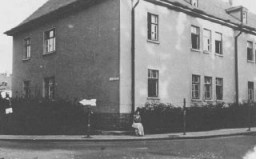
The International Military Tribunal was a court convened jointly by the victorious Allied governments. Here the Soviet, British, American, and French flags hang behind the judges' bench.
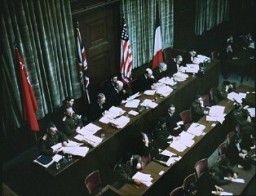
The remodeled courtroom at Nuremberg, site of the International Military Tribunal. Germany, November 15-20, 1945.
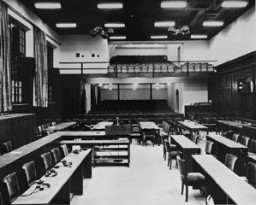
The Palace of Justice in Nuremberg, Germany, where the International Military Tribunal trial of war criminals was held. The flags of the four prosecuting countries (French, American, British, and Soviet) hang above the entrance.

US Chief Prosecutor Robert H. Jackson delivers the opening speech of the American prosecution at the International Military Tribunal. Nuremberg, Germany. November 21, 1945.
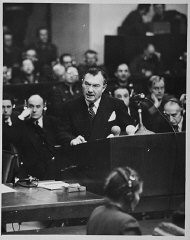
US Major Frank B. Wallis (standing center), a member of the trial legal staff, presents the prosecution's case to the International Military Tribunal at Nuremberg. A chart (top left) shows where the defendants (bottom left) fit into the organizational scheme of the Nazi Party. At right are lawyers for the four prosecuting countries. Nuremberg, Germany, November 22, 1945. The trials of leading German officials before the International Military Tribunal are the best known of the postwar war crimes trials.…
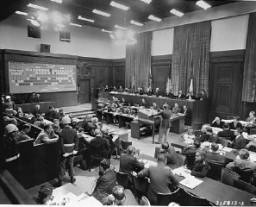
View of the defendants in the dock at the International Military Tribunal trial of war criminals at Nuremberg. November 1945.
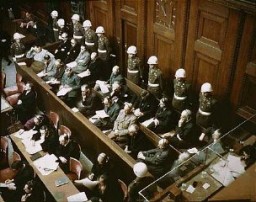
Photographs, artifacts, and a map presented as evidence at the International Military Tribunal. Nuremberg, Germany, between November 20, 1945, and October 1, 1946.
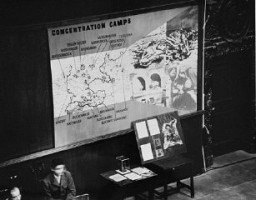
Birds-eye view of the fenced-in cell block where defendants in the International Military Tribunal war crimes trial were imprisoned. Nuremberg, Germany, between November 20, 1945, and October 1, 1946.
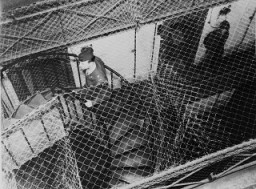
A tank guards the entrance to the Palace of Justice in Nuremberg, Germany, site of the International Military Tribunal. The trial formally opened in on November 20, 1945, just six and a half months after Germany surrendered.
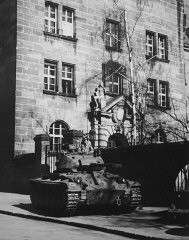
The defendants listen as the prosecution begins introducing documents at the International Military Tribunal trial of war criminals at Nuremberg. November 22, 1945.
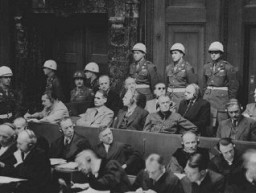
View of a criminal wing in the prison at Nuremberg, housing war crimes trials defendants. Baltic guards under the supervision of American authorities patrol the wing and keep constant watch over the prisoners. The upper floors are screened off with heavy chicken wire to discourage suicide attempts. Nuremberg, Germany, between November 20, 1945, and October 1, 1946.
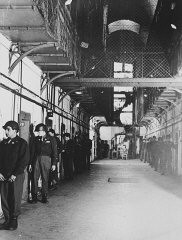
The defendants' box at the Nuremberg trial. Hermann Göring is seated at the far left of the first row. Nuremberg, Germany, 1945-1946.
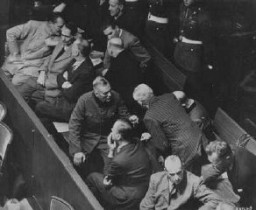
An American correspondent reads a special edition of the Nürnberger newspaper reporting the sentences handed down by the International Military Tribunal. Nuremberg, Germany, October 1, 1946.
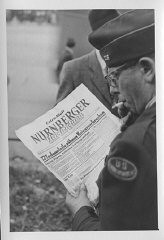
An armored car parked outside the gate of the Palace of Justice in Nuremberg on the day the judgment of the International Military Tribunal was handed down. Nuremberg, Germany, October 1, 1946.
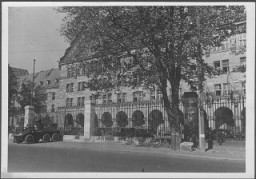
Otto Ohlendorf, commander of Einsatzgruppe D (mobile killing unit D), during Trial 9 of the Subsequent Nuremberg Proceedings. This photograph shows Ohlendorf pleading "not guilty" during his arraignment at the Einsatzgruppen Trial. Nuremberg, Germany, September 15, 1947.
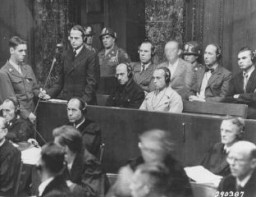
Walter Gumpert testifies for the prosecution during the Krupp Trial. Gumpert worked as a machinist at a Krupp factory. December 16, 1947.
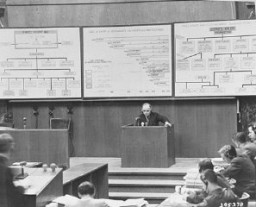
We would like to thank Crown Family Philanthropies, Abe and Ida Cooper Foundation, the Claims Conference, EVZ, and BMF for supporting the ongoing work to create content and resources for the Holocaust Encyclopedia. View the list of donor acknowledgement.